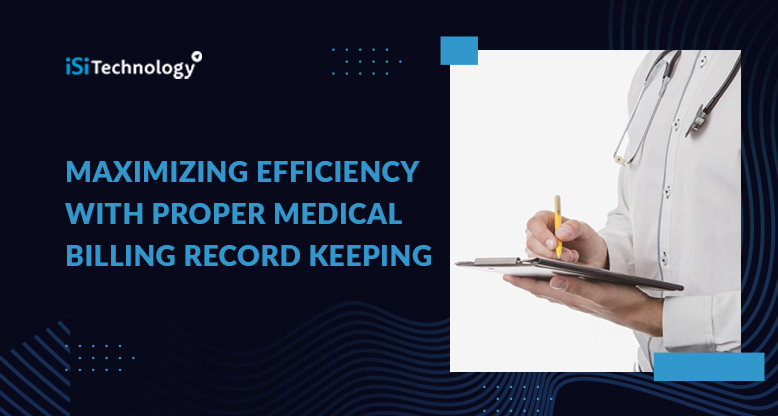Maximizing Efficiency With Proper Medical Billing Record Keeping

Medical billing records are crucial documents that aid in revenue generation and ensure timely payments to healthcare providers.
Creating these records is a time-consuming and complex process. The list of terms used in medical billing is also extensive and quite tricky to learn.
Here, we outline the eight medical billing process steps and discuss common terms you will encounter while creating or evaluating medical billing records.
Let’s dive in.
What are the Steps in the Medical Billing Process?

Medical billers go through several measures to ensure that healthcare providers receive accurate and timely reimbursements when they provide services to patients.
The exact timeline for the process depends on various circumstances—they can span days, weeks, or even months.
Here are the eight crucial medical billing process steps:
1. Registering the Patient
Patient registration is the first—and arguably most important—step of the medical billing workflow.
It involves collecting a patient’s basic information, which includes:
- Name
- Birthdate
- Reason for the visit to the healthcare facility
The medical biller or administrative staff member will also collect and verify their insurance details, including the following:
- Name of their insurer
- Patient’s policy number
The medical biller will input these details in a file to be used as a reference for the rest of the steps.
2. Determining Financial Responsibility
The next step is to determine who is financially responsible for the treatments or procedures performed, and to what extent the insurer provides coverage for the patient. Complete and accurate insurance details are crucial for this step.
If certain services or procedures are not covered by insurance, the biller will inform the patient that they must pay.
3. Creating the Superbill
During the check-in process, the administrative staff member will ask the patient to fill out forms for their file. If it is a return visit, the patient will be asked to verify or update their file information. They will need to show their identity proof and a valid insurance card. They must also pay any pending co-payments.
When the patient is checking out, a medical coder will translate the patient’s medical billing records from the visit into diagnostic and procedural codes. They will create an itemized report called a superbill containing all the data about the patient and the visit.
This superbill will include the following details:
- Information about the healthcare provider and clinician
- The patient’s demographic data and medical history
- Details about the rendered medical procedures and services
- The relevant diagnostic and procedural codes
4. Generating the Claim
Next, the medical biller will use the superbill to generate a healthcare claim.
Before creating the claim, the biller will scrub or carefully examine it. This ensures that the claim fulfills the standards of the Health Insurance Portability and Accountability Act of 1996 (HIPAA) and meets payer compliance, including medical format and coding standards.
5. Submitting the Claim
Once the biller has gone over the claim for compliance and accuracy, they will submit it to the patient’s insurance company. Typically, healthcare providers electronically transmit claims to clearinghouses. These are third-party companies that act as liaisons between providers and insurers.
Note that high-volume payers like Medicaid are exceptions to this as they accept direct claims from healthcare providers.
6. Monitoring Adjudication of the Claim
In the adjudication process, the payer will review the medical claim and determine if it is compliant and valid. If so, the payer will determine the reimbursement the provider will get. In this step, the payer may accept, reject, or deny the claim.
If they accept the claim, they will pay according to the insurer’s agreement with the provider.
Rejected claims contain errors that need correction and resubmission. If a payer denies a claim, it means they refuse to pay the reimbursement.
7. Preparing the Patient Statement
After the claim is processed, the patient will receive a billing statement for any outstanding charges that the payer has not paid. It includes a complete list of the following details:
- Information about the provided procedures and services and their costs
- The reimbursement from the insurer
- The remaining amount the patient should pay
8. Following up on the Statement
Finally, the medical biller must ensure timely payment of the bills. They will follow up with patients with pending payments and remind them about their charges.
If necessary, the biller will forward patient accounts to collection agencies.
What is an EOB in Medical Billing?

In medical billing, an Explanation of Benefits (EOB) is a statement that provides an overview of the medical benefits that the patient’s insurance provider covers.
It includes a breakdown of the following:
- A list of services that the insurer provides
- Hospital or clinic charges
- The extent of coverage of the patient’s insurance for rendered services and procedures
- The amount the insurer has agreed to pay
- What the patient needs to pay from their pocket
What is an ERA in Medical Billing?
An Electronic Remittance Advice (ERA) explains a claim payment that an insurer electronically sends to a provider.
It details how the insurer has adjusted reimbursements and lists the following:
- Contract agreements
- Secondary payers
- Coverage of benefits
- Expected copayments and coinsurance
- Reasons for claim denial and denied services and codes
- Patient’s applicable financial liability
- Paid claims
- Reimbursed amounts
- Payment bundling or splitting
- Payment methods
What is RVU in Medical Billing?
Relative Value Units (RVU) is a term used in medical billing that refers to a set of standard values that Medicare has assigned to calculate healthcare service costs. RVU makes it easier to pay healthcare providers by taking their services into account.
Billers use these values while submitting claims to ensure proper reimbursement of treatments and other services.
Final Thoughts
Creating medical billing records takes a lot of time and effort. The steps in the process are also complex and lengthy. Medical insurance billing software can help ease the process and avoid errors, claim denials, and rejections. It also boosts overall productivity by ensuring smooth and seamless workflow management.
Moreover, the software provides access to custom reporting, automatic claim data downloads and imports, and other top-notch features. This will help you ensure operational efficiency and maximize revenue generation.
If you are looking for the right medical billing software for your business, look no further than ISI Technology. This company provides businesses in the healthcare industry with an impressive range of billing software solutions. You can choose from Medicaid billing software, NEMT billing software, and more.